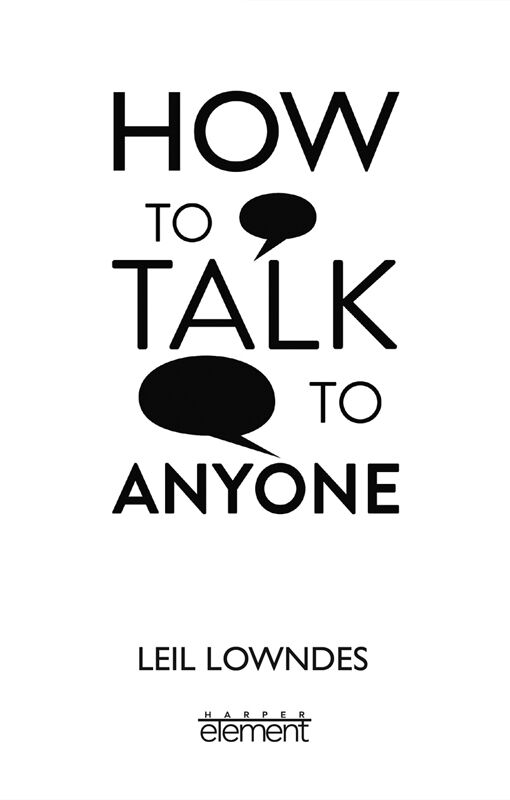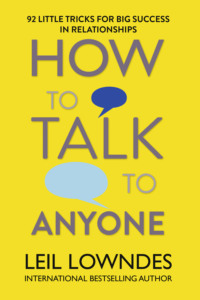
Полная версия
How to Talk to Anyone: 92 Little Tricks for Big Success in Relationships


Copyright
HarperElement
An Imprint of HarperCollinsPublishers 1 London Bridge Street London SE1 9GF
www.harpercollins.co.uk
First published by Thorsons 1999
This edition published by HarperElement 2014
© Leil Lowndes 1999, 2014
Cover layout design © HarperCollinsPublishers Ltd 2014
A catalogue record for this book is available from the British Library
While every effort has been made to trace the owners of copyright material reproduced herein and secure permissions, the publishers would like to apologise for any omissions and will be pleased to incorporate missing acknowledgements in any future edition of this book.
Leil Lowndes asserts the moral right to be identified as the author of this work
All rights reserved under International and Pan-American Copyright Conventions. By payment of the required fees, you have been granted the nonexclusive, non-transferable right to access and read the text of this ebook on screen. No part of this text may be reproduced, transmitted, downloaded, decompiled, reverse engineered, or stored in or introduced into any information storage retrieval system, in any form or by any means, whether electronic or mechanical, now known or hereinafter invented, without the express written permission of HarperCollins ebooks.
HarperCollinsPublishers has made every reasonable effort to ensure that any picture content and written content in this ebook has been included or removed in accordance with the contractual and technological constraints in operation at the time of publication.
Find out more about HarperCollins and the environment at www.harpercollins.co.uk/green
Source ISBN: 9780722538074
Ebook Edition © 2014 ISBN: 9780007369867 Version: 2018-03-07
ALSO BY LEIL LOWNDES
How to Feel Confident
How to Make Anyone Like You
How to Make Anyone Fall in Love with You
Contents
Cover
Title Page
Copyright
Also by Leil Lowndes
Preface: Having it all
Part One: You only have ten seconds to show you’re a somebody
The incredible, inescapable, unique essence of you
1 The flooding smile
2 Sticky eyes
3 Epoxy eyes
4 Hang by your teeth
5 The big-baby pivot
6 Hello old friend
7 Limit the fidget
8 Hans’s horse sense
9 Watch the scene before you make the scene
Part Two: What do I say after I say ‘hello’?
Small talk, your verbal welcome mat
10 The mood match
11 Prosaic with passion
12 Always wear a Whatzit
13 Whoozat?
14 Eavesdrop in
15 Never the naked city
16 Never the naked job
17 Never the naked introduction
18 Be a word detective
19 The swivelling spotlight
20 Parroting
21 Encore!
22 Ac-cen-tu-ate the pos-i-tive
23 The latest news … don’t leave home without it
Part Three: How to talk like the big boys ’n’ girls
Welcome to the human jungle
24 What do you do – NOT!
25 The nutshell resume
26 Your personal thesaurus
27 Kill the quick ‘me, too!’
28 Comm-YOU-nication
29 The exclusive smile
30 Don’t touch a cliché with a ten-foot pole
31 Use jawsmith’s jive
32 Call a spade a spade
33 Trash the teasing
34 It’s the receiver’s ball
35 The broken record
36 Big shots don’t slobber
37 Never the naked thank you
Part Four: How to be an insider in any crowd
What are they all talking about?
38 Scramble therapy
39 Learn a little Gobbledygook
40 Baring their hot button
41 Read their rags
42 Clear ‘custom’
43 Bluffing for bargains
Part Five: Why, we’re just alike!
We’re like peas in a pod
44 Be a copycat
45 Echoing
46 Potent imaging
47 Employ empathizers
48 Anatomically correct empathizers
49 The premature we
50 Instant history
Part Six: The power of praise, the folly of flattery
Praise reappraised
51 Grapevine glory
52 Carrier pigeon kudos
53 Implied magnificence
54 Accidental adulation
55 The killer compliment
56 Little strokes
57 The knee-jerk ‘wow!’
58 Boomeranging
59 The tombstone game
Part Seven: Direct dial their hearts
How to be a hit in another show
60 Talking gestures
61 Name shower
62 Oh wow, it’s you!’
63 The sneaky screen
64 Salute the spouse
65 What colour is your time?
66 Constantly changing outgoing message
67 Your ten-second audition
68 The ho-hum caper
69 ‘I hear your other line’
70 Instant replay
Part Eight: How to work a party like a politician works a room
The politician’s six-point party checklist
71 Munching or mingling
72 Rubberneck the room
73 Be the chooser, not the choosee
74 Come-hither hands
75 Tracking
76 The business card dossier
77 Eyeball selling
Part Nine: Little tricks of big winners
The most treacherous glass ceiling of all
78 See no bloopers, hear no bloopers
79 Lend a helping tongue
80 Bare the buried WIIFM
81 Let ’em savour the favour
82 Tit for (wait … wait) tat
83 Parties are for pratter
84 Dinner’s for dining
85 Chance encounters are for chitchat
86 Empty their tanks
87 Echo the EMO
88 My goof, your gain
89 Leave an escape hatch
90 Buttercups for their boss
91 Lead the listeners
92 The great scorecard in the sky
A final word: Your destiny
Back Ads
Notes
Select bibliography
About the author
About the Publisher

Have you ever admired those successful people who seem to have it all? You see them chatting confidently at business meetings, comfortably at social parties. They’re the ones with the best jobs, the nicest spouses, the coolest friends, the biggest bank accounts, the most fashionable postcodes.
But wait a minute! A lot of them aren’t cleverer than you. They’re not more educated than you. They’re not even better looking! So what is it? (Some people suspect they inherited it. Others say they married it, or were just plain lucky. Tell them to think again.) What it boils down to is their more skilful way of dealing with fellow human beings.
You see, nobody gets to the top alone. Over the years, people who seem to ‘have it all’ have captured the hearts and conquered the minds of hundreds of others who helped boost them, rung by rung, to the top of whatever corporate or social ladder they chose.
Wannabes wandering around at the foot of the ladder often gaze up and complain that the Big Boys and Big Girls at the top are snobs. When Big Players don’t give them their friendship, love, or business, they call them ‘cliquish’ or accuse them of belonging to an ‘old-boy network.’ Some grumble they hit their heads against a ‘glass ceiling.’
The complaining Little Leaguers never realize the rejection was their own fault. They’ll never know they blew the affair, the friendship, or the deal due to their own communications fumbles. Why don’t they see it? Because some of the moves Big Winners make are so smooth, so subtle, it takes another Big Winner to recognize them.
The old boys – in the days when top management was, unfortunately, mainly old boys – complimented each other by saying, ‘Buddy, you ain’t no accident.’ They bestowed this slang tribute with a tinge of jealousy when one old boy saw some sensitive act the other had executed.
Indeed, today the old (and not so old) boys and girls who run our country, our corporations, and our arts ‘ain’t no accident.’ Each has a bag of tricks, a magic, a Midas touch that turns everything they do into success.
What’s in their bag of tricks? You’ll find a lot of things: There’s a substance that solidifies friendships, a wizardry that wins minds, and a magic that makes people fall in love with them. There’s also a quality that makes bosses hire and then promote, a characteristic that keeps clients coming back, and an asset that makes customers buy from them and not the competition. We all have a few of those tricks in our bags, some more than others. Those with a whole lot of them are Big Winners in life. How to Talk to Anyone gives you ninety-two of these little tricks used by Big Winners so you, too, can play the game to perfection and get whatever you want in life.
How the techniques were developed
Many years ago, a drama teacher, exasperated at my bad acting in a college play, shouted, ‘No! No! Your body is belying your words. Every tiny movement, every body position,’ he howled, ‘divulges your private thoughts. Your face can make seven thousand different expressions, and each exposes precisely who you are and what you are thinking at any particular moment.’ Then he said something I’ll never forget: ‘And your body! The way you move is your autobiography in motion.’
How right he was! On the stage of real life, every physical move you make subliminally tells everyone in eyeshot the story of your life. Dogs hear sounds our ears can’t detect. Bats see shapes in the darkness that elude our eyes. And people make moves that are beneath human consciousness but have tremendous power to attract or repel. Every smile, every frown, every syllable you utter, every arbitrary choice of word that passes between your lips, can draw others toward you, or make them want to run away.
Men, did your gut feeling ever tell you to jump ship on a deal? Women, did your women’s intuition make you accept or reject an offer? On a conscious level, we may not be aware of what the hunch is. But like the ear of the dog or the eye of the bat, the elements that make up subliminal sentiments are very real.
Imagine, please, two humans in a complex box wired with circuits to record all the signals flowing between the two. As many as 10,000 units of information flow per second. ‘Probably the lifetime efforts of roughly half the adult population of the United States would be required to sort the units in one hour’s interaction between two subjects,’ a University of Pennsylvania communications authority estimates.1
With the zillions of subtle actions and reactions zapping back and forth between two human beings, can we come up with concrete techniques to make our every communication clear, confident, credible, and charismatic?
Determined to find the answer, I read practically every book written on communications skills, charisma, and chemistry between people. I explored hundreds of studies conducted around the world on what qualities made up leadership and credibility. Intrepid social scientists left no stone unturned in their quest to find the formula. For example, optimistic Chinese researchers, hoping charisma might be in the diet, went so far as to compare the relationship of personality type to the catecholamine level in subjects’ urine.2 Needless to say, their thesis was soon shelved!
Most of the studies simply confirmed Dale Carnegie’s 1936 classic, How to Win Friends and Influence People.3 His wisdom for the ages said success lay in smiling, showing interest in other people, and making them feel good about themselves. ‘That’s no surprise,’ I thought. It’s as true today as it was over sixty years ago.
So if Dale Carnegie and hundreds of others since offer the same astute advice, why do any of us lack the right stuff to win friends and influence people?
Suppose a sage told you, ‘When in China, speak Chinese’ – but gave you no language lessons? Dale Carnegie and many communications experts are like that sage. They tell us what to do, but not how to do it. In today’s sophisticated world, it’s not enough to say ‘smile’ or ‘give sincere compliments.’ Cynical business people today see more subtleties in your smile, more complexities in your compliment. Accomplished or attractive people are surrounded by smiling sycophants feigning interest and fawning all over them. Prospects are tired of salespeople who say, ‘The suit looks great on you,’ when their fingers are caressing cash register keys. Women are wary of suitors who say, ‘You are beautiful,’ when the bedroom door is in view.
The world is a very different place than it was in 1936, and we need a new formula for success. To find it, I observed the superstars of today. I explored techniques used by top salespeople to close the sale, speakers to convince, clergy to convert, performers to engross, sex symbols to seduce, and athletes to win.
I found concrete building blocks to the elusive qualities that lead to their success.
Then I broke them down into easily digestible, news-you-can-use techniques. I gave each a name that will quickly come to mind when you find yourself in a communications conundrum. As I developed the techniques, I began sharing them with audiences around the US. Participants in my communications seminars gave me their ideas. My clients, many of them CEOs of Fortune 500 companies*, enthusiastically offered their observations.
When I was in the presence of the most successful and beloved leaders, I analyzed their body language, their facial expressions. I listened carefully to their casual conversations, their timing, and their choice of words. I watched as they dealt with their families, their friends, their associates, and their adversaries. Every time I detected a little nip of magic in their communicating, I asked them to pluck it out with tweezers and expose it to the bright light of consciousness. We analyzed it together, and I then turned it into a technique others could duplicate and profit from.
In this book are my findings and the strokes of some of those very effective folks. Some are subtle. Some are surprising. But all are achievable. When you master them, everyone from new acquaintances to family, friends, and business associates will happily open their hearts, their homes, their companies, even their wallets to give you whatever they can.
There’s a bonus. As you sail through life with your new communications skills, you’ll look back and see some very happy givers smiling in your wake.
* The top 500 companies in terms of turnover every year, as listed in Fortune magazine.
There are two kinds of people in this life:
Those who walk into a room and say, ‘Well, here I am!’
And those who walk in and say, ‘Ahh, there you are.’

The moment two humans lay eyes on each other has awesome potency. The first sight of you is a brilliant holograph. It burns its way into your new acquaintance’s eyes and can stay emblazoned in his or her memory forever.
Artists are sometimes able to capture this quicksilver, fleeting emotional response. I have a friend, Robert Grossman, an accomplished caricature artist who draws regularly for Forbes, Newsweek, Sports Illustrated, Rolling Stone and other popular North American publications. Bob has a unique gift for capturing not only the physical appearance of his subjects, but zeroing in on the essence of their personalities. The bodies and souls of hundreds of luminaries radiate from his sketch pad. One glance at his caricatures of famous people and you can see, for instance, the insecure arrogance of Madonna, the imperiousness of Newt Gingrich, the bitchiness of Leona Helmsley.
Sometimes at a party, Bob will do a quick sketch on a cocktail napkin of a guest. Hovering over Bob’s shoulder, the onlookers gasp as they watch their friend’s image and essence materialize before their eyes. When he’s finished drawing, he puts his pen down and hands the napkin to the subject. Often a puzzled look comes over the subject’s face. He or she usually mumbles some politeness like, ‘Well, er, that’s great. But it really isn’t me.’
The crowd’s convincing crescendo of ‘Oh yes it is!’ drowns the subject out and squelches any lingering doubt. The confused subject is left to stare back at the world’s view of himself or herself in the napkin.
Once when I was visiting Bob’s studio, I asked him how he could capture people’s personalities so well. He said, ‘It’s simple. I just look at them.’
‘No,’ I asked, ‘How do you capture their personalities? Don’t you have to do a lot of research about their lifestyle, their history?’
‘No, I told you, Leil, I just look at them.’
‘Huh?’
He went on to explain, ‘Almost every facet of people’s personalities is evident from their appearance, their posture, the way they move. For instance …’ he said, calling me over to a file where he kept his caricatures of political figures.
‘See,’ Bob said, pointing to angles on various presidential body parts, ‘here’s the boyishness of Clinton,’ showing me his half smile; ‘the awkwardness of George Bush,’ pointing to his shoulder angle; ‘the charm of Reagan,’ putting his finger on the ex-president’s smiling eyes; ‘the shiftiness of Nixon,’ pointing to the furtive tilt of his head. Digging a little deeper into his file, he pulled out Franklin Delano Roosevelt and, pointing to the nose high in the air, ‘Here’s the pride of FDR.’ It’s all in the face and the body.
First impressions are indelible. Why? Because in our fast-paced information-overload world of multiple stimuli bombarding us every second, people’s heads are spinning. They must form quick judgments to make sense of the world and get on with what they have to do. So, whenever people meet you, they take an instant mental snapshot. That image of you becomes the data they deal with for a very long time.
Your body shrieks before your lips can speak
Is their data accurate? Amazingly enough, yes. Even before your lips part and the first syllable escapes, the essence of YOU has already axed its way into their brains. The way you look and the way you move is more than 80 per cent of someone’s first impression of you. Not one word need be spoken.
I’ve lived and worked in countries where I didn’t speak the native language. Yet, without one understandable syllable spoken between us, the years proved my first impressions were on target. Whenever I met new colleagues, I could tell instantly how friendly they felt toward me, how confident they were, and approximately how much stature they had in the company. I could sense, just from seeing them move, which were the heavyweights and which were the welterweights.
I have no extrasensory skill. You’d know, too. How? Because before you have had time to process a rational thought, you get a sixth sense about someone. Studies have shown emotional reactions occur even before the brain has had time to register what’s causing that reaction.4 Thus the moment someone looks at you, he or she experiences a massive hit, the impact of which lays the groundwork for the entire relationship. Bob told me he captures that first hit in creating his caricatures.







